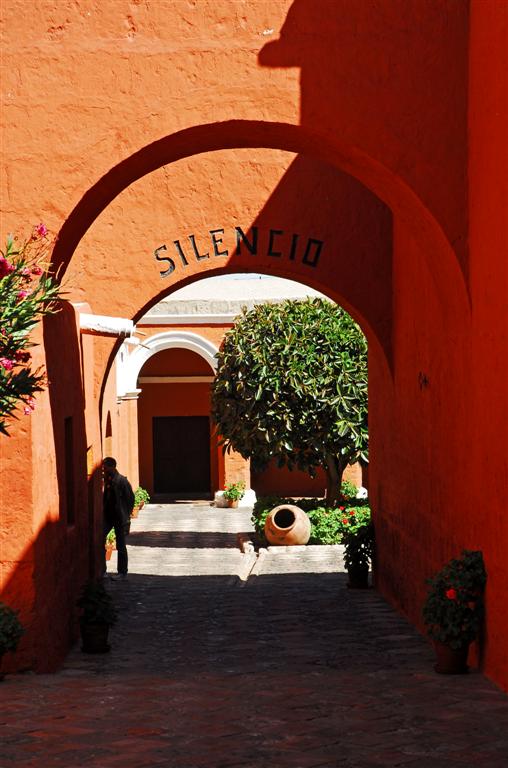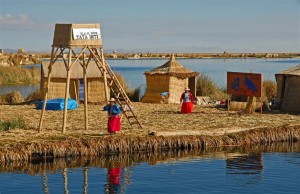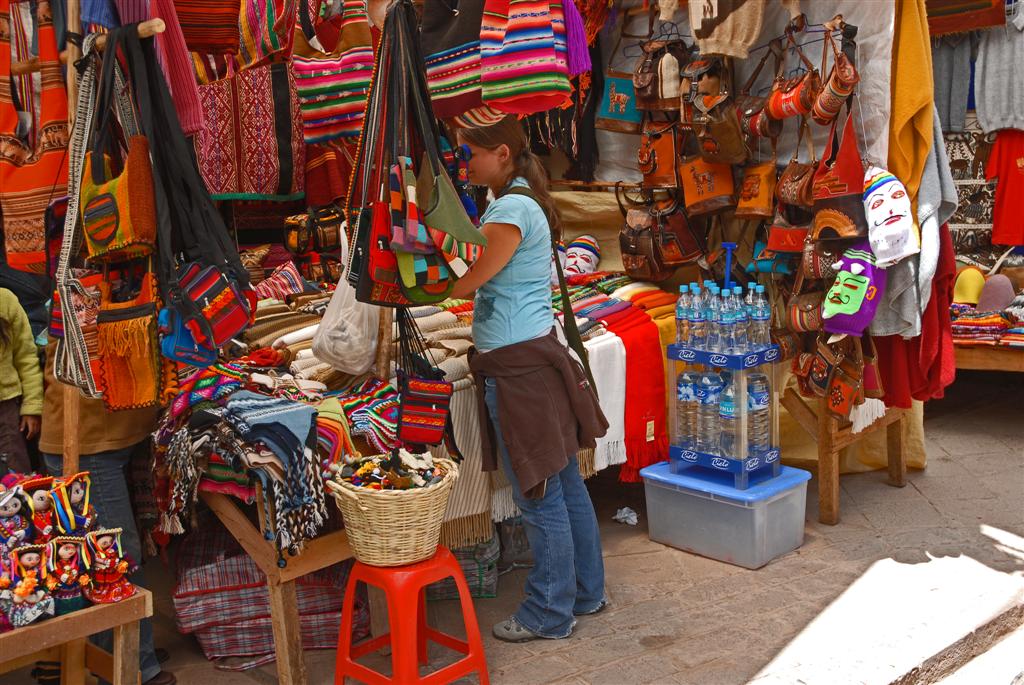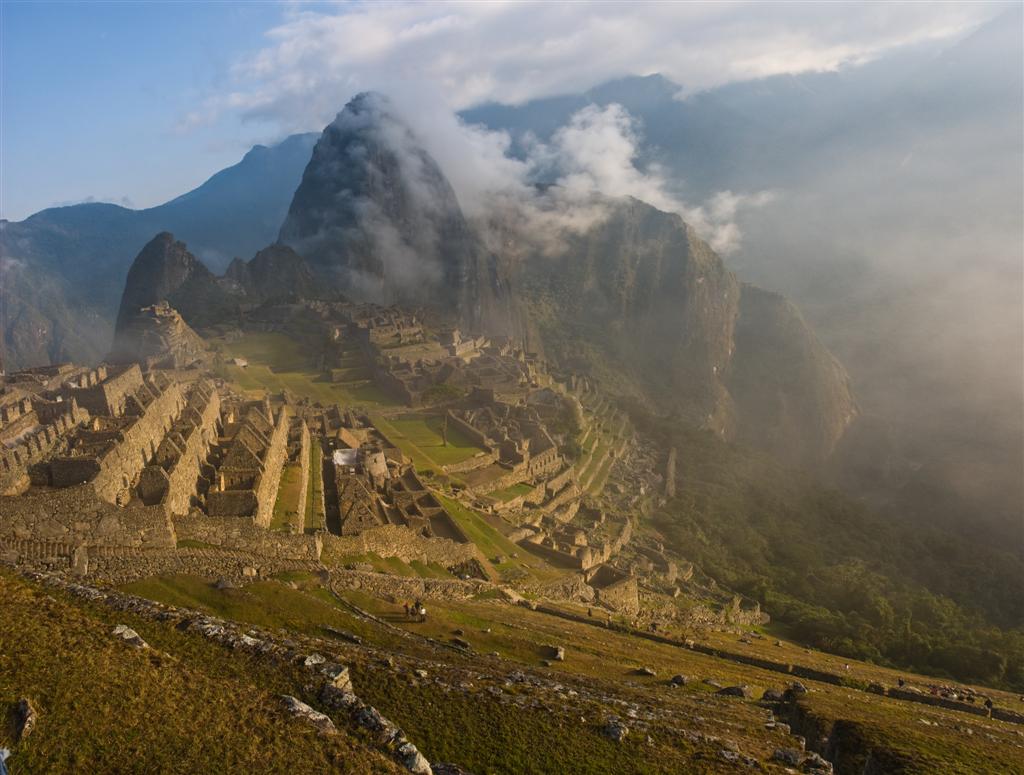One of the benefits of cruising is the opportunity to get off the boat and travel inland to see the countryside away from the coastal areas. We haven’t done too much of that yet, but did take advantage of the opportunity this month and spent two weeks traveling in Peru. The trip south on the boat from here is a hard bash to weather. Some friends recently had to sail 1,800 miles to get to Lima (which is 800 miles away), so we took the easy route and caught a 767 out of Guayaquil.
We got to our hotel in Lima about 8:30 at night and asked the taxi driver if he would take us back to the airport at 4:00 the next morning to pick up Brittney. Sure enough we walked out of the hotel and he was waiting for us asleep in his car out front. Brit had left Seattle at 9:00 the morning before and was understandably a bit tired when she got there. We spent two days checking out Lima and the suburb of Miraflores where we were staying, then headed south on a bus. We took the overnight bus to Arequipa, which left Lima around 6 pm and got into Arequipa around 9 am the next morning.

Arequipa is a very large city in the lower altitudes (7,700 feet) of the Andes Mountains. 13 years ago an expedition unearthed several sites where they found 500 year old remains of frozen humans they believed had been sacrificed to the Gods on the mountain tops. Like the Mayan people in Guatemala the Incas had no written language, so all the history is speculation based on archeological findings and interpretation. In the case of the sites on the mountaintop, the remains were covered and frozen for years and remained very well intact. The best specimen was named Juanita, a girl estimated to be a young teen when she was sacrificed, whose remains included even her hair, teeth and clothing. Today Juanita’a remains are on display at a museum im Arequipa, likely not the destination intended by her tribemates making the sacrifice.
Also in Arequipa is a huge monastery that was home to cloistered nuns. The monastery has been restored to resemble original living arrangements in many rooms and is open for public viewing. The facility is enormous, encompassing 20,000 square meters and took us a couple of hours to tour one afternoon.
Unfortunately Arequipa is where my altitude sickness problems began. Our trip was planned to gradually increase in altitude, allowing us to acclimate as we headed higher towards Machu Picchu. I had a persistent headache in Arequipa the three days we were there, which is only at 7,700 feet above sea level. Our next stop was at the end of an 8 hour bus ride uphill into the Altiplano (high plains) of the Andes, ending at Lake Titicaca. It was amazing to be up at 12,500 feet above sea level in rolling plains, not mountainous terrain, with a lake a 100 miles long. But I contracted all the typical symptoms of altitude sickness and ended up in bed for a day and a half feeling like I had a bad flu and a head that was just going to completely explode. Fortunately Brit found Machu Pizza in town so Rob & her were able to eat while I was sick. And luckily some serious doses of medicine in the form of caffiene and ibuprofen proved succesful and I got to go on the daylong tour of the lake.

It started at the Uros islands near the town of Puno where we were staying. The islands are floating, and made completely of reeds. They are constructed of sections of the reed root structures lashed together and anchored to the bottom of the lake in the shallows near shore. When we stepped from the tour boats we felt the surface flex under us as we walked around. It was a very interesting place. The locals have lived like that for 500 years on both the Peruvian and Bolivian sides of the lake. Recently the Bolivians all moved ashore but the Peruvians remain on the islands where they now welcome tourist boats during high season to supplement their fishing income.
Our second stop that day was at a real island in Lake Titicaca named Taquile. We had a 45 minute walk to the top of the island where the town square was at 4,000 meters above sea level (13,123 feet – nearly the TOP of Mt. Rainier which is 14,410). The locals were dressed in their traditional attiture, which you can see in Rob’s pictures in the Peru album. Their costumes are a hodgepodge of styles worn by outsiders to the island since the Spanish conquistadors. The colors of the men’s hats signify their marital and social status, and the women’s skirts are up to seven layers thick. I don’t remember what the layers signify, but I’m sure it’s important. The women are spinning yarn as they walk and the men all knit, as you can see in some of the pictures. Unfortunately they have an intended income stream from tourists taking photos and we object to that strategy. We had a nice lunch on the island and headed back to Puno on the boat.
The next morning we boarded the Andean Explorer, a Peru Rail train headed to Cusco. It was our biggest financial splurge of the trip, but worth the high price. It was an 8 hour ride and included lunch and snacks along the way. We traveled north across the altiplano and down into the valleys of the Andes mountains. We passed through the highest point of our trip at 14,172 feet and started a descent into Cusco that my head was greatful to feel. Cusco is known as “gringo central” in Peru because of the number of tourists visiting the Sacred Valley area, and we stayed 5 days.

Our first day there we took a trip to the town of Pisac where they have a Sunday market that we believed would rival the one we had enjoyed so much in Chichicastenango, Guatemala. We weren’t disappointed at all by the size of the market and the quality of the goods for sale, but were surprised at how calm and quiet is was compared to Chichi. We all had fun shopping for souvenirs, including Brittney who realized she didn’t need to know Spanish to barter, just how to convert US dollars to Peruvian Soles and punch numbers into a little hand held calculator that was passed back and forth between her and the vendor.
The second day we took a Sacred Valley tour to see the Inca ruins in Pisac, Ollantaytambo and Chinchero. We were at a much lower altitude than Lake Titicaca, but we quickly learned the Incas liked to build their temples high on the hills and we still had a significant amount of climbing to do in the mountains. The ruins were fascinating though, and the quality of the Inca stonework is amazing. The next day we just poked around Cusco and had a quiet day before the climax of our journey, the trip up to Machu Picchu.

We scheduled Machu Picchu as our final stop to ensure we were acclimated to the altitude and because we wanted to save the best for last. And we were not disappointed; it is incredible to witness in person. Perched high on a mountaintop, surrounded on three sides by the Urubamba river running below and mountain peaks in every direction, the setting is absolutely magical. It’s understandable why the Inca rulers treked three days from Cusco to this retreat (or rather why the Inca rulers had their slaves carry them for three days on the trail). Our first afternoon Rob & I hiked up the Inca trail towards Cusco to a spot they call the Sun Gate, where you first enter the valley that Machu Picchu is in. It was about 45 minutes up the trail and the views along the way were incredible. And since we chose not to make the three day hike up the real Inca trail, it was fun to walk on it a little bit. The next morning we joined 400 of our new best friends (a la Tikal) to see Machu Picchu at sunrise. Again, like Tikal, it was worth the 4:00 am alarm. We had a private guide who showed us through the ruins and pointed out the sights we had read about in the “Self Guided Tour to Machu Picchu”. It was a great day and we were blessed with incredible sunshine for our photos.
Now we’re back in Ecuador onboard the boat and settling back in. The customs agent at the airport in Guayaquil stamped our passports with another 90 day visa, so we don’t have to leave for Panama before the rainy season is over. But we’re ready to move on so I think we’ll head south to Salinas and check out the Puerto Lucia Yacht Club for a few weeks. It’s about a day south of here near Guayaquil, and a good location to explore southern Ecuador from.
Today on Yohelah we’re glad to be home with great memories of the wonderful people and beautiful sights of Peru…..